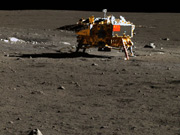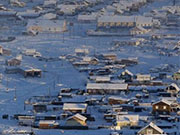

Making a return trip to the edge of space typically requires enough jet power to thrust the craft through the stratosphere.
But aviation specialists have built a glider capable of reaching altitudes of 90,000ft (27,430 metres) using nothing but wind - and are set to attempt to become the highest plane in history in June.
If it succeeds, it will be the highest that any winged vehicle, powered or otherwise has gone.
Aviation specialists have built a glider capable of reaching altitudes of 90,000ft (27,430 metres) using nothing but wind - and are set to attempt to become the highest plane in history in June.
Called the Airbus Perlan II, the glider is the world's first engineless aircraft designed to reach such heights by riding so-called 'mountain waves'.
Allan McArtor, the Chairman and CEO of Airbus Group, which is sponsoring the craft, told Forbes it could will attempt to reach its optimal cruising altitude of 90,000 feet as early as this coming June in Argentina.
Airbus says that any insight gained into flight at increasingly higher altitudes also has implications for the future of both sub-sonic and supersonic or hypersonic aviation, where given the right technology, higher operating altitudes could provide a range of potential advantages.
'Airbus recently filed a patent for hypersonic passenger craft that will go to suborbital space and back down again,' said McArtor.
'It's in that region of suborbital space that Perlan 2 will be flying.'
Glider pilots have surfed so-called mountain waves since 1932. The process is similar to surfing on a wave in the ocean, except the glider is in the wave rather than on the surface of the wave. Winds in the Polar Vortex can reach speeds of 260 knots and upwards allowing the mountain waves to propagate upwards into the stratosphere. An infographic revealing more about the project is pictured
Airbus says that any insight gained into flight at increasingly higher altitudes also has implications for the future of both sub-sonic and supersonic or hypersonic aviation, where given the right technology, higher operating altitudes could provide a range of potential advantages.
The goal of the project is to 'open up a world of new discoveries related to high-altitude flight, climate change and space exploration', explained the firm.
The Perlan II is a pressurised sailplane designed to ride air currents that, in certain mountainous regions near the north and south poles, can reach into the stratosphere.
Despite having no engine, the glider's true flight speed at that altitude will be more than 400mph (643km/h) and the air density will be less than two per cent of what it is at sea level.
The crew will breathe pure oxygen provided by a rebreather system, similar to what astronauts use in space.
In addition to its two-person crew, the aircraft carries scientific instruments to provide new insight into climate change and the upper atmosphere.
Because it lacks an engine, Perlan II can explore the edge of space without polluting the atmosphere it will study.
Glider pilots have surfed on so-called mountain waves since 1932.
The process is similar to surfing on a wave in the ocean, except the glider is in the wave rather than on the surface of the wave.
Mountain waves form when winds of at least 15 knots cross over a mountain range perpendicularly and the atmosphere is 'stable' waves will form on the lee side of the mountains. A glider uses the upward moving part of this wave system to climb.
But the maximum altitude of a mountain is typically at the boundary between the troposphere and the stratosphere, and this is because the cold air of the mountain wave encounters warmer air at the boundary and can't rise further.
Einar Enevoldson, a Nasa test pilot and founder of the project, saw evidence that in regions closer to the Poles in winter, the waves could extend above the troposphere and well into the stratosphere.
Previously, no-one had searched for waves in the stratosphere in sub-polar regions in winter.
From 1992 until 1998, he gathered more evidence that these waves existed, and found they might be strong enough to lift a sailplane to high altitudes.
Then, in 1998 Dr Elizabeth Austin joined Mr Enevoldson in the search for an understanding of stratospheric mountain waves.
She found that the Polar Vortex, and one of its principal components, the stratospheric polar night jet that only exists in winter, provided the high speed wind in the stratosphere that powered incredibly high waves.
 |
Day|Week

 China releases HD true color images of lunar surface
China releases HD true color images of lunar surface To-be flight attendants undergo training at snow-covered field
To-be flight attendants undergo training at snow-covered field Aerial photos taken on J-11 fighter
Aerial photos taken on J-11 fighter 'Coldest town in China' — a fairyland you don't want to miss
'Coldest town in China' — a fairyland you don't want to miss Deep love for breathtaking Hainan
Deep love for breathtaking Hainan Beautiful Chinese tennis player Wang Qiang goes viral online
Beautiful Chinese tennis player Wang Qiang goes viral online Minus 71 degrees! Coldest village on earth
Minus 71 degrees! Coldest village on earth Chinese pole dancing master opens class in Tianjin
Chinese pole dancing master opens class in Tianjin The most beautiful town of snow in China
The most beautiful town of snow in China SWAT members hold romantic wedding in E China
SWAT members hold romantic wedding in E China